HLT100 Semester 2 Case Study: Exploring Claire's Health Issues
VerifiedAdded on 2022/09/28
|8
|2144
|17
Case Study
AI Summary
This case study analyzes Claire's medical conditions, addressing infant thermoregulation, gestational diabetes, and a fractured radius. Question 1 explores infant thermoregulation challenges due to underdeveloped skin, covering heat loss mechanisms and homeothermy. Question 2 examines Claire's gestational diabetes, detailing its causes, risks, and preventative measures. Question 3 focuses on the healing process of a radius fracture, comparing clinical timelines with fetal bone development. Question 4 discusses hyperemesis gravidarum, its effects on both mother and fetus, and management strategies. The study integrates concepts from anatomy, physiology, and pathophysiology to provide a comprehensive understanding of the presented health issues. The analysis utilizes relevant research to support the explanations.

Claire’s Case Study 1
Claire’s Case Study
By
Course
Professor
University
City
Date
Claire’s Case Study
By
Course
Professor
University
City
Date
Paraphrase This Document
Need a fresh take? Get an instant paraphrase of this document with our AI Paraphraser
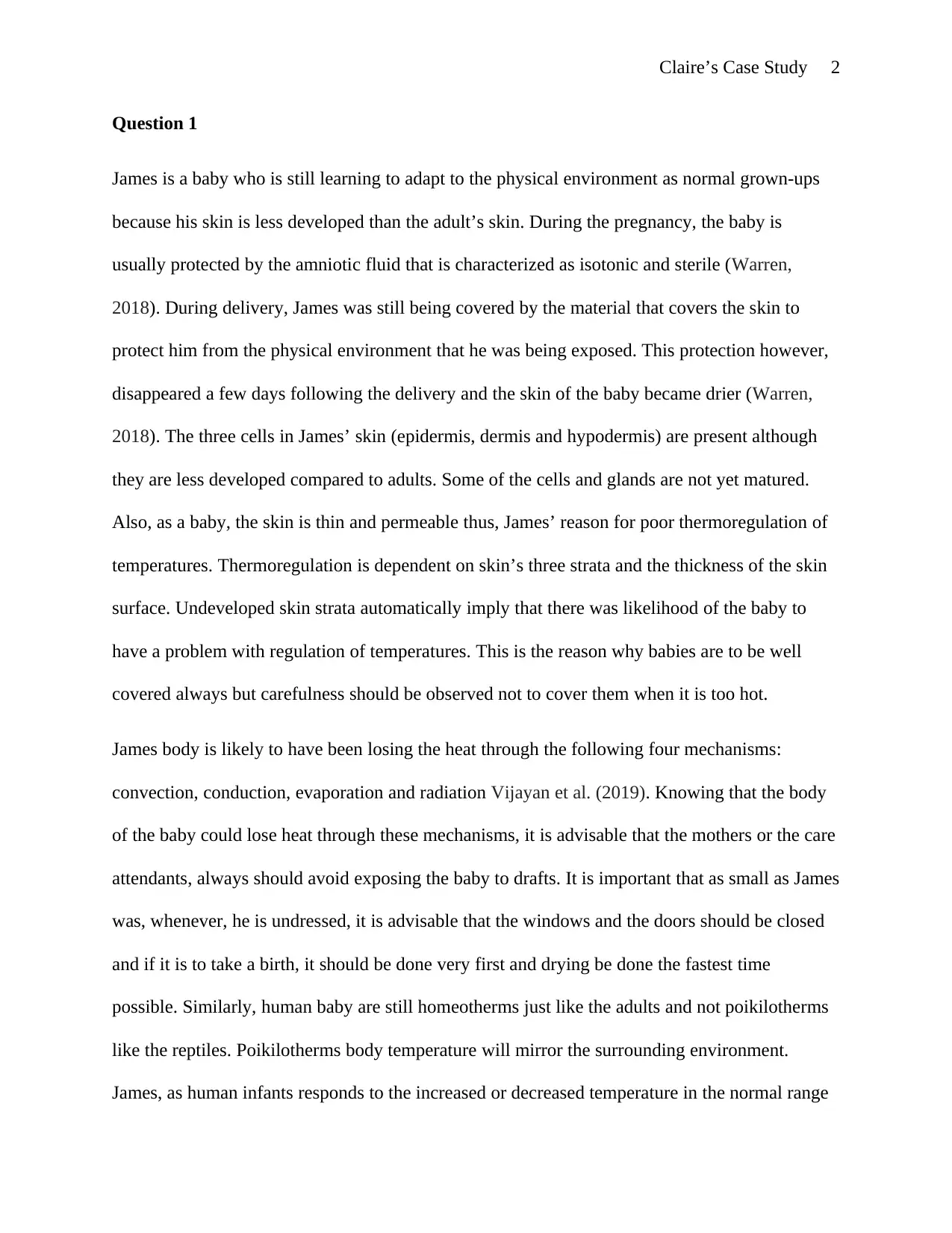
Claire’s Case Study 2
Question 1
James is a baby who is still learning to adapt to the physical environment as normal grown-ups
because his skin is less developed than the adult’s skin. During the pregnancy, the baby is
usually protected by the amniotic fluid that is characterized as isotonic and sterile (Warren,
2018). During delivery, James was still being covered by the material that covers the skin to
protect him from the physical environment that he was being exposed. This protection however,
disappeared a few days following the delivery and the skin of the baby became drier (Warren,
2018). The three cells in James’ skin (epidermis, dermis and hypodermis) are present although
they are less developed compared to adults. Some of the cells and glands are not yet matured.
Also, as a baby, the skin is thin and permeable thus, James’ reason for poor thermoregulation of
temperatures. Thermoregulation is dependent on skin’s three strata and the thickness of the skin
surface. Undeveloped skin strata automatically imply that there was likelihood of the baby to
have a problem with regulation of temperatures. This is the reason why babies are to be well
covered always but carefulness should be observed not to cover them when it is too hot.
James body is likely to have been losing the heat through the following four mechanisms:
convection, conduction, evaporation and radiation Vijayan et al. (2019). Knowing that the body
of the baby could lose heat through these mechanisms, it is advisable that the mothers or the care
attendants, always should avoid exposing the baby to drafts. It is important that as small as James
was, whenever, he is undressed, it is advisable that the windows and the doors should be closed
and if it is to take a birth, it should be done very first and drying be done the fastest time
possible. Similarly, human baby are still homeotherms just like the adults and not poikilotherms
like the reptiles. Poikilotherms body temperature will mirror the surrounding environment.
James, as human infants responds to the increased or decreased temperature in the normal range
Question 1
James is a baby who is still learning to adapt to the physical environment as normal grown-ups
because his skin is less developed than the adult’s skin. During the pregnancy, the baby is
usually protected by the amniotic fluid that is characterized as isotonic and sterile (Warren,
2018). During delivery, James was still being covered by the material that covers the skin to
protect him from the physical environment that he was being exposed. This protection however,
disappeared a few days following the delivery and the skin of the baby became drier (Warren,
2018). The three cells in James’ skin (epidermis, dermis and hypodermis) are present although
they are less developed compared to adults. Some of the cells and glands are not yet matured.
Also, as a baby, the skin is thin and permeable thus, James’ reason for poor thermoregulation of
temperatures. Thermoregulation is dependent on skin’s three strata and the thickness of the skin
surface. Undeveloped skin strata automatically imply that there was likelihood of the baby to
have a problem with regulation of temperatures. This is the reason why babies are to be well
covered always but carefulness should be observed not to cover them when it is too hot.
James body is likely to have been losing the heat through the following four mechanisms:
convection, conduction, evaporation and radiation Vijayan et al. (2019). Knowing that the body
of the baby could lose heat through these mechanisms, it is advisable that the mothers or the care
attendants, always should avoid exposing the baby to drafts. It is important that as small as James
was, whenever, he is undressed, it is advisable that the windows and the doors should be closed
and if it is to take a birth, it should be done very first and drying be done the fastest time
possible. Similarly, human baby are still homeotherms just like the adults and not poikilotherms
like the reptiles. Poikilotherms body temperature will mirror the surrounding environment.
James, as human infants responds to the increased or decreased temperature in the normal range
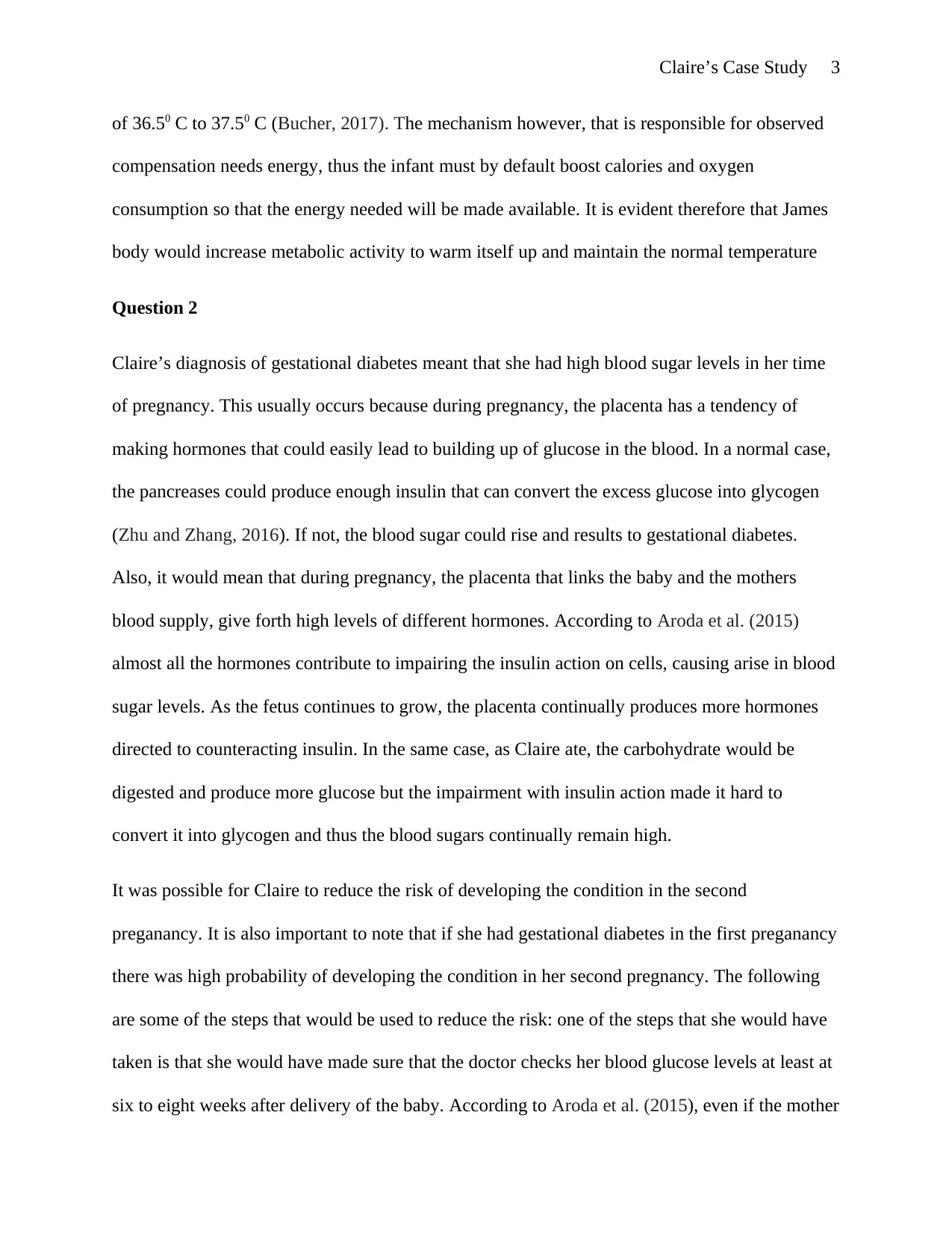
Claire’s Case Study 3
of 36.50 C to 37.50 C (Bucher, 2017). The mechanism however, that is responsible for observed
compensation needs energy, thus the infant must by default boost calories and oxygen
consumption so that the energy needed will be made available. It is evident therefore that James
body would increase metabolic activity to warm itself up and maintain the normal temperature
Question 2
Claire’s diagnosis of gestational diabetes meant that she had high blood sugar levels in her time
of pregnancy. This usually occurs because during pregnancy, the placenta has a tendency of
making hormones that could easily lead to building up of glucose in the blood. In a normal case,
the pancreases could produce enough insulin that can convert the excess glucose into glycogen
(Zhu and Zhang, 2016). If not, the blood sugar could rise and results to gestational diabetes.
Also, it would mean that during pregnancy, the placenta that links the baby and the mothers
blood supply, give forth high levels of different hormones. According to Aroda et al. (2015)
almost all the hormones contribute to impairing the insulin action on cells, causing arise in blood
sugar levels. As the fetus continues to grow, the placenta continually produces more hormones
directed to counteracting insulin. In the same case, as Claire ate, the carbohydrate would be
digested and produce more glucose but the impairment with insulin action made it hard to
convert it into glycogen and thus the blood sugars continually remain high.
It was possible for Claire to reduce the risk of developing the condition in the second
preganancy. It is also important to note that if she had gestational diabetes in the first preganancy
there was high probability of developing the condition in her second pregnancy. The following
are some of the steps that would be used to reduce the risk: one of the steps that she would have
taken is that she would have made sure that the doctor checks her blood glucose levels at least at
six to eight weeks after delivery of the baby. According to Aroda et al. (2015), even if the mother
of 36.50 C to 37.50 C (Bucher, 2017). The mechanism however, that is responsible for observed
compensation needs energy, thus the infant must by default boost calories and oxygen
consumption so that the energy needed will be made available. It is evident therefore that James
body would increase metabolic activity to warm itself up and maintain the normal temperature
Question 2
Claire’s diagnosis of gestational diabetes meant that she had high blood sugar levels in her time
of pregnancy. This usually occurs because during pregnancy, the placenta has a tendency of
making hormones that could easily lead to building up of glucose in the blood. In a normal case,
the pancreases could produce enough insulin that can convert the excess glucose into glycogen
(Zhu and Zhang, 2016). If not, the blood sugar could rise and results to gestational diabetes.
Also, it would mean that during pregnancy, the placenta that links the baby and the mothers
blood supply, give forth high levels of different hormones. According to Aroda et al. (2015)
almost all the hormones contribute to impairing the insulin action on cells, causing arise in blood
sugar levels. As the fetus continues to grow, the placenta continually produces more hormones
directed to counteracting insulin. In the same case, as Claire ate, the carbohydrate would be
digested and produce more glucose but the impairment with insulin action made it hard to
convert it into glycogen and thus the blood sugars continually remain high.
It was possible for Claire to reduce the risk of developing the condition in the second
preganancy. It is also important to note that if she had gestational diabetes in the first preganancy
there was high probability of developing the condition in her second pregnancy. The following
are some of the steps that would be used to reduce the risk: one of the steps that she would have
taken is that she would have made sure that the doctor checks her blood glucose levels at least at
six to eight weeks after delivery of the baby. According to Aroda et al. (2015), even if the mother
⊘ This is a preview!⊘
Do you want full access?
Subscribe today to unlock all pages.

Trusted by 1+ million students worldwide
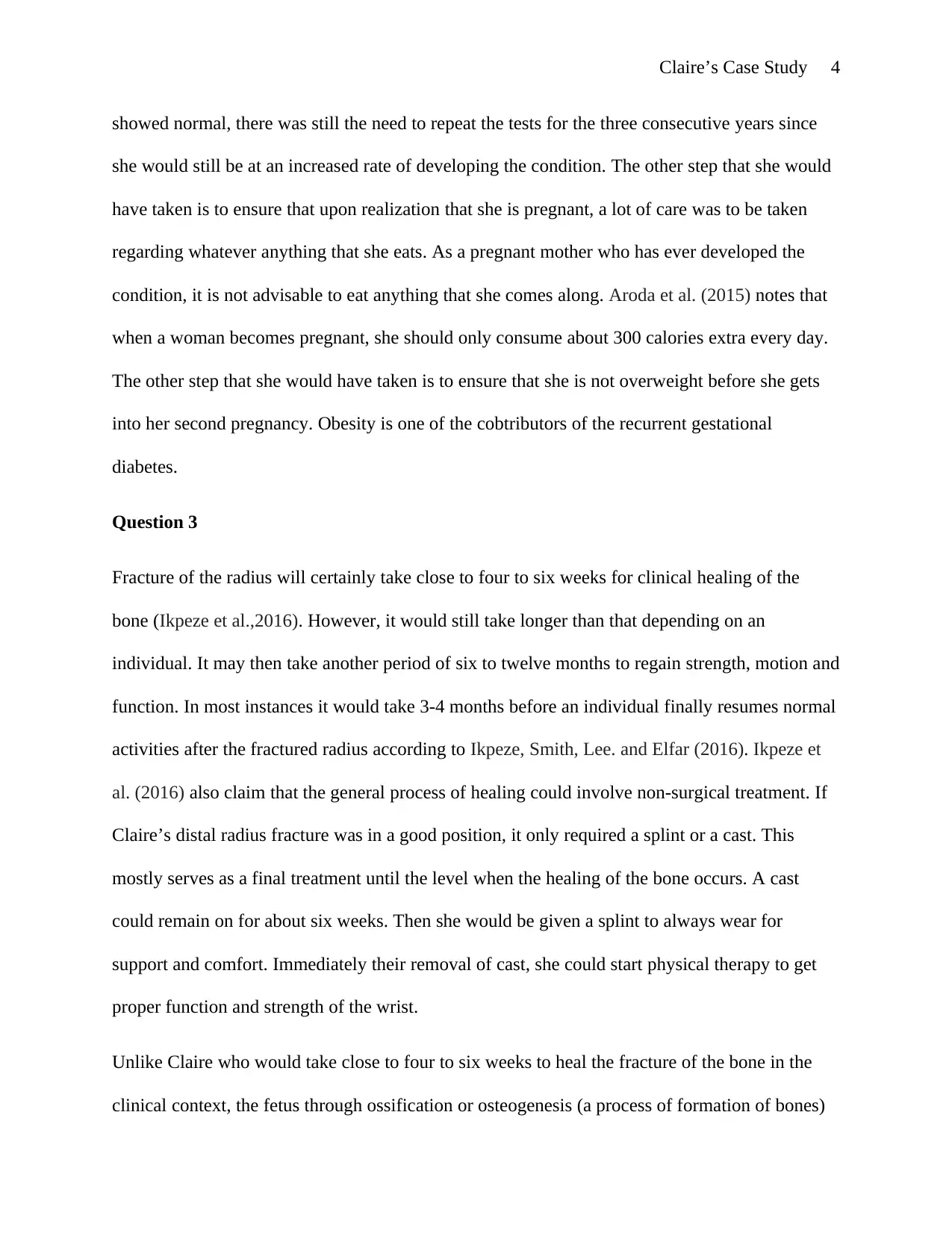
Claire’s Case Study 4
showed normal, there was still the need to repeat the tests for the three consecutive years since
she would still be at an increased rate of developing the condition. The other step that she would
have taken is to ensure that upon realization that she is pregnant, a lot of care was to be taken
regarding whatever anything that she eats. As a pregnant mother who has ever developed the
condition, it is not advisable to eat anything that she comes along. Aroda et al. (2015) notes that
when a woman becomes pregnant, she should only consume about 300 calories extra every day.
The other step that she would have taken is to ensure that she is not overweight before she gets
into her second pregnancy. Obesity is one of the cobtributors of the recurrent gestational
diabetes.
Question 3
Fracture of the radius will certainly take close to four to six weeks for clinical healing of the
bone (Ikpeze et al.,2016). However, it would still take longer than that depending on an
individual. It may then take another period of six to twelve months to regain strength, motion and
function. In most instances it would take 3-4 months before an individual finally resumes normal
activities after the fractured radius according to Ikpeze, Smith, Lee. and Elfar (2016). Ikpeze et
al. (2016) also claim that the general process of healing could involve non-surgical treatment. If
Claire’s distal radius fracture was in a good position, it only required a splint or a cast. This
mostly serves as a final treatment until the level when the healing of the bone occurs. A cast
could remain on for about six weeks. Then she would be given a splint to always wear for
support and comfort. Immediately their removal of cast, she could start physical therapy to get
proper function and strength of the wrist.
Unlike Claire who would take close to four to six weeks to heal the fracture of the bone in the
clinical context, the fetus through ossification or osteogenesis (a process of formation of bones)
showed normal, there was still the need to repeat the tests for the three consecutive years since
she would still be at an increased rate of developing the condition. The other step that she would
have taken is to ensure that upon realization that she is pregnant, a lot of care was to be taken
regarding whatever anything that she eats. As a pregnant mother who has ever developed the
condition, it is not advisable to eat anything that she comes along. Aroda et al. (2015) notes that
when a woman becomes pregnant, she should only consume about 300 calories extra every day.
The other step that she would have taken is to ensure that she is not overweight before she gets
into her second pregnancy. Obesity is one of the cobtributors of the recurrent gestational
diabetes.
Question 3
Fracture of the radius will certainly take close to four to six weeks for clinical healing of the
bone (Ikpeze et al.,2016). However, it would still take longer than that depending on an
individual. It may then take another period of six to twelve months to regain strength, motion and
function. In most instances it would take 3-4 months before an individual finally resumes normal
activities after the fractured radius according to Ikpeze, Smith, Lee. and Elfar (2016). Ikpeze et
al. (2016) also claim that the general process of healing could involve non-surgical treatment. If
Claire’s distal radius fracture was in a good position, it only required a splint or a cast. This
mostly serves as a final treatment until the level when the healing of the bone occurs. A cast
could remain on for about six weeks. Then she would be given a splint to always wear for
support and comfort. Immediately their removal of cast, she could start physical therapy to get
proper function and strength of the wrist.
Unlike Claire who would take close to four to six weeks to heal the fracture of the bone in the
clinical context, the fetus through ossification or osteogenesis (a process of formation of bones)
Paraphrase This Document
Need a fresh take? Get an instant paraphrase of this document with our AI Paraphraser
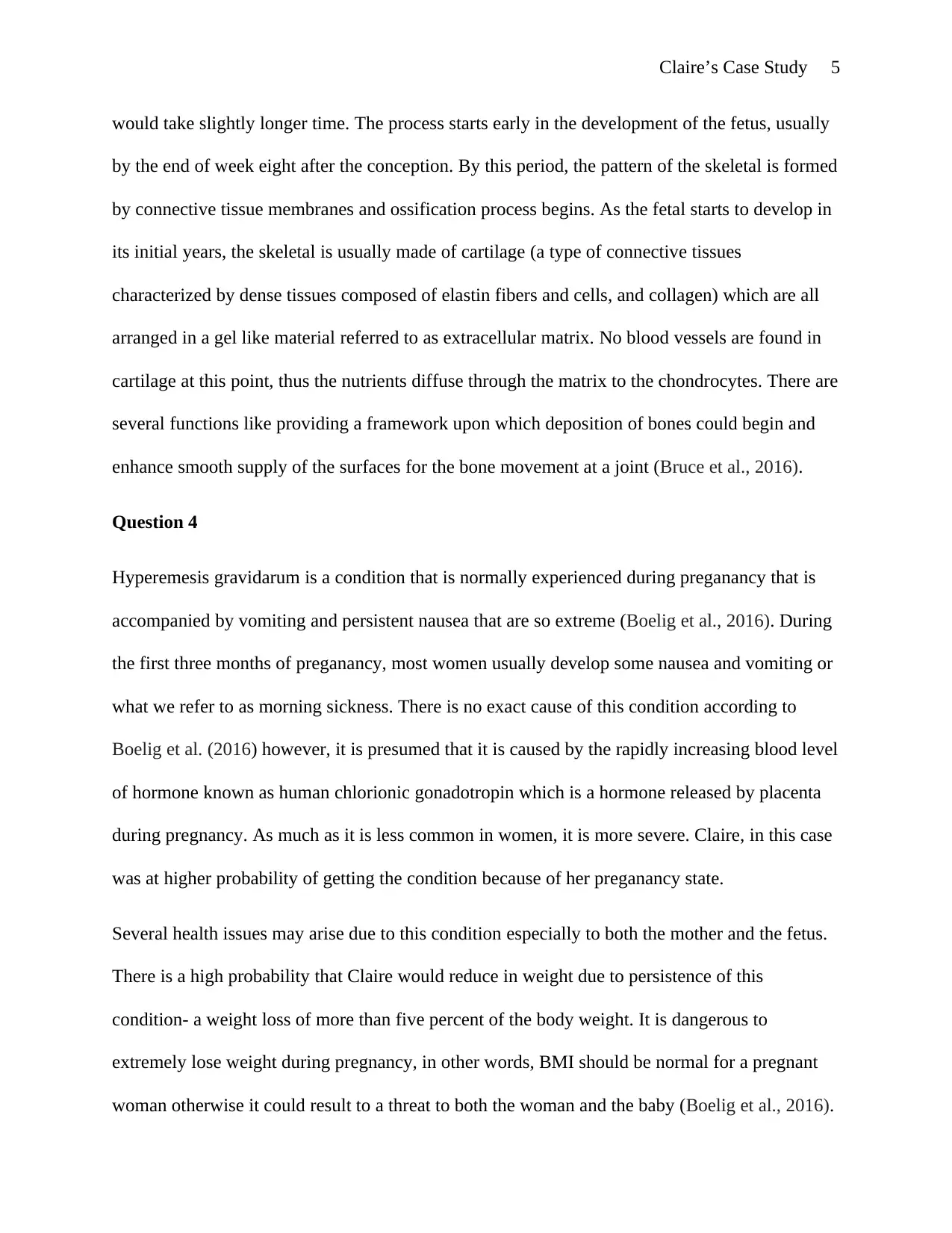
Claire’s Case Study 5
would take slightly longer time. The process starts early in the development of the fetus, usually
by the end of week eight after the conception. By this period, the pattern of the skeletal is formed
by connective tissue membranes and ossification process begins. As the fetal starts to develop in
its initial years, the skeletal is usually made of cartilage (a type of connective tissues
characterized by dense tissues composed of elastin fibers and cells, and collagen) which are all
arranged in a gel like material referred to as extracellular matrix. No blood vessels are found in
cartilage at this point, thus the nutrients diffuse through the matrix to the chondrocytes. There are
several functions like providing a framework upon which deposition of bones could begin and
enhance smooth supply of the surfaces for the bone movement at a joint (Bruce et al., 2016).
Question 4
Hyperemesis gravidarum is a condition that is normally experienced during preganancy that is
accompanied by vomiting and persistent nausea that are so extreme (Boelig et al., 2016). During
the first three months of preganancy, most women usually develop some nausea and vomiting or
what we refer to as morning sickness. There is no exact cause of this condition according to
Boelig et al. (2016) however, it is presumed that it is caused by the rapidly increasing blood level
of hormone known as human chlorionic gonadotropin which is a hormone released by placenta
during pregnancy. As much as it is less common in women, it is more severe. Claire, in this case
was at higher probability of getting the condition because of her preganancy state.
Several health issues may arise due to this condition especially to both the mother and the fetus.
There is a high probability that Claire would reduce in weight due to persistence of this
condition- a weight loss of more than five percent of the body weight. It is dangerous to
extremely lose weight during pregnancy, in other words, BMI should be normal for a pregnant
woman otherwise it could result to a threat to both the woman and the baby (Boelig et al., 2016).
would take slightly longer time. The process starts early in the development of the fetus, usually
by the end of week eight after the conception. By this period, the pattern of the skeletal is formed
by connective tissue membranes and ossification process begins. As the fetal starts to develop in
its initial years, the skeletal is usually made of cartilage (a type of connective tissues
characterized by dense tissues composed of elastin fibers and cells, and collagen) which are all
arranged in a gel like material referred to as extracellular matrix. No blood vessels are found in
cartilage at this point, thus the nutrients diffuse through the matrix to the chondrocytes. There are
several functions like providing a framework upon which deposition of bones could begin and
enhance smooth supply of the surfaces for the bone movement at a joint (Bruce et al., 2016).
Question 4
Hyperemesis gravidarum is a condition that is normally experienced during preganancy that is
accompanied by vomiting and persistent nausea that are so extreme (Boelig et al., 2016). During
the first three months of preganancy, most women usually develop some nausea and vomiting or
what we refer to as morning sickness. There is no exact cause of this condition according to
Boelig et al. (2016) however, it is presumed that it is caused by the rapidly increasing blood level
of hormone known as human chlorionic gonadotropin which is a hormone released by placenta
during pregnancy. As much as it is less common in women, it is more severe. Claire, in this case
was at higher probability of getting the condition because of her preganancy state.
Several health issues may arise due to this condition especially to both the mother and the fetus.
There is a high probability that Claire would reduce in weight due to persistence of this
condition- a weight loss of more than five percent of the body weight. It is dangerous to
extremely lose weight during pregnancy, in other words, BMI should be normal for a pregnant
woman otherwise it could result to a threat to both the woman and the baby (Boelig et al., 2016).
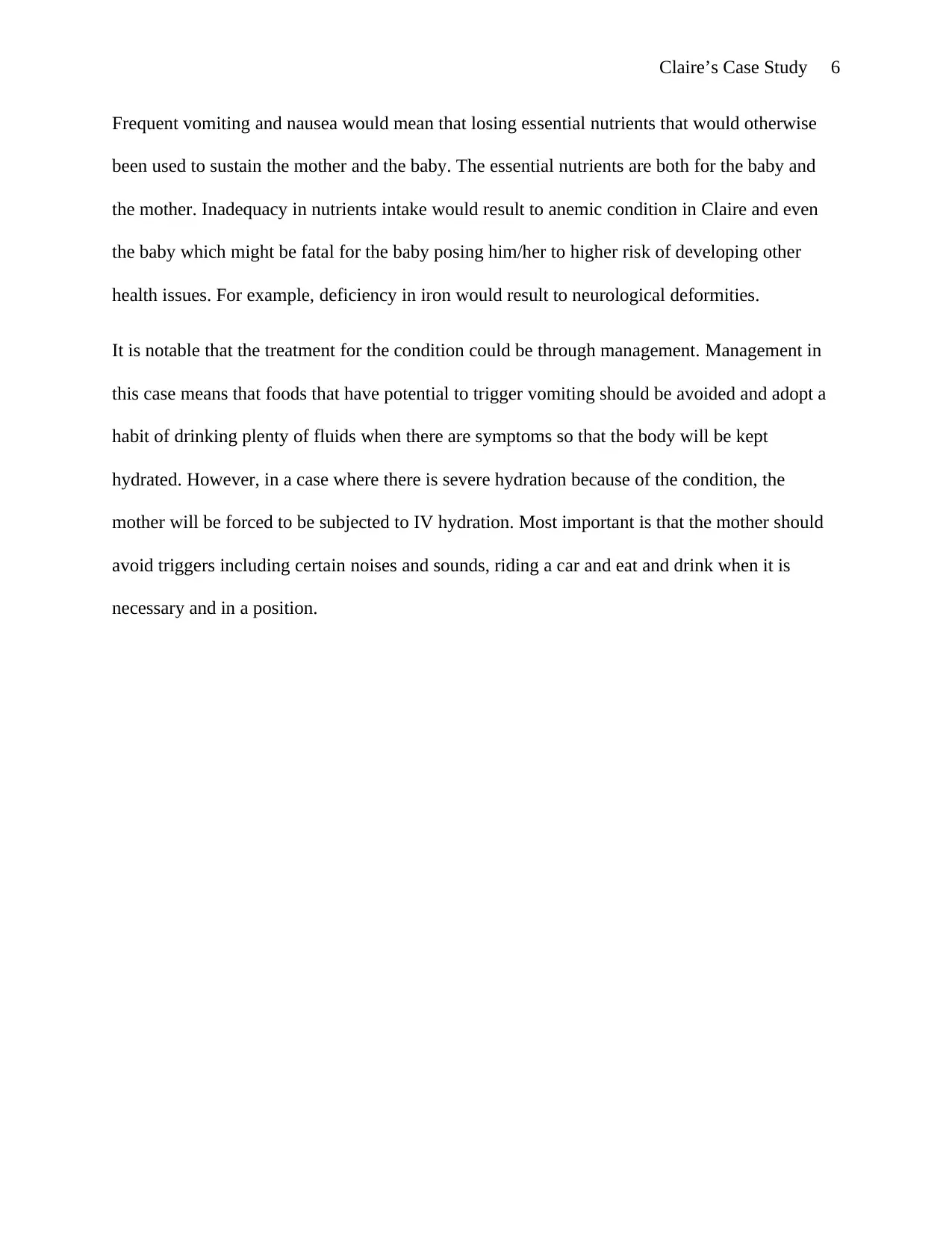
Claire’s Case Study 6
Frequent vomiting and nausea would mean that losing essential nutrients that would otherwise
been used to sustain the mother and the baby. The essential nutrients are both for the baby and
the mother. Inadequacy in nutrients intake would result to anemic condition in Claire and even
the baby which might be fatal for the baby posing him/her to higher risk of developing other
health issues. For example, deficiency in iron would result to neurological deformities.
It is notable that the treatment for the condition could be through management. Management in
this case means that foods that have potential to trigger vomiting should be avoided and adopt a
habit of drinking plenty of fluids when there are symptoms so that the body will be kept
hydrated. However, in a case where there is severe hydration because of the condition, the
mother will be forced to be subjected to IV hydration. Most important is that the mother should
avoid triggers including certain noises and sounds, riding a car and eat and drink when it is
necessary and in a position.
Frequent vomiting and nausea would mean that losing essential nutrients that would otherwise
been used to sustain the mother and the baby. The essential nutrients are both for the baby and
the mother. Inadequacy in nutrients intake would result to anemic condition in Claire and even
the baby which might be fatal for the baby posing him/her to higher risk of developing other
health issues. For example, deficiency in iron would result to neurological deformities.
It is notable that the treatment for the condition could be through management. Management in
this case means that foods that have potential to trigger vomiting should be avoided and adopt a
habit of drinking plenty of fluids when there are symptoms so that the body will be kept
hydrated. However, in a case where there is severe hydration because of the condition, the
mother will be forced to be subjected to IV hydration. Most important is that the mother should
avoid triggers including certain noises and sounds, riding a car and eat and drink when it is
necessary and in a position.
⊘ This is a preview!⊘
Do you want full access?
Subscribe today to unlock all pages.

Trusted by 1+ million students worldwide
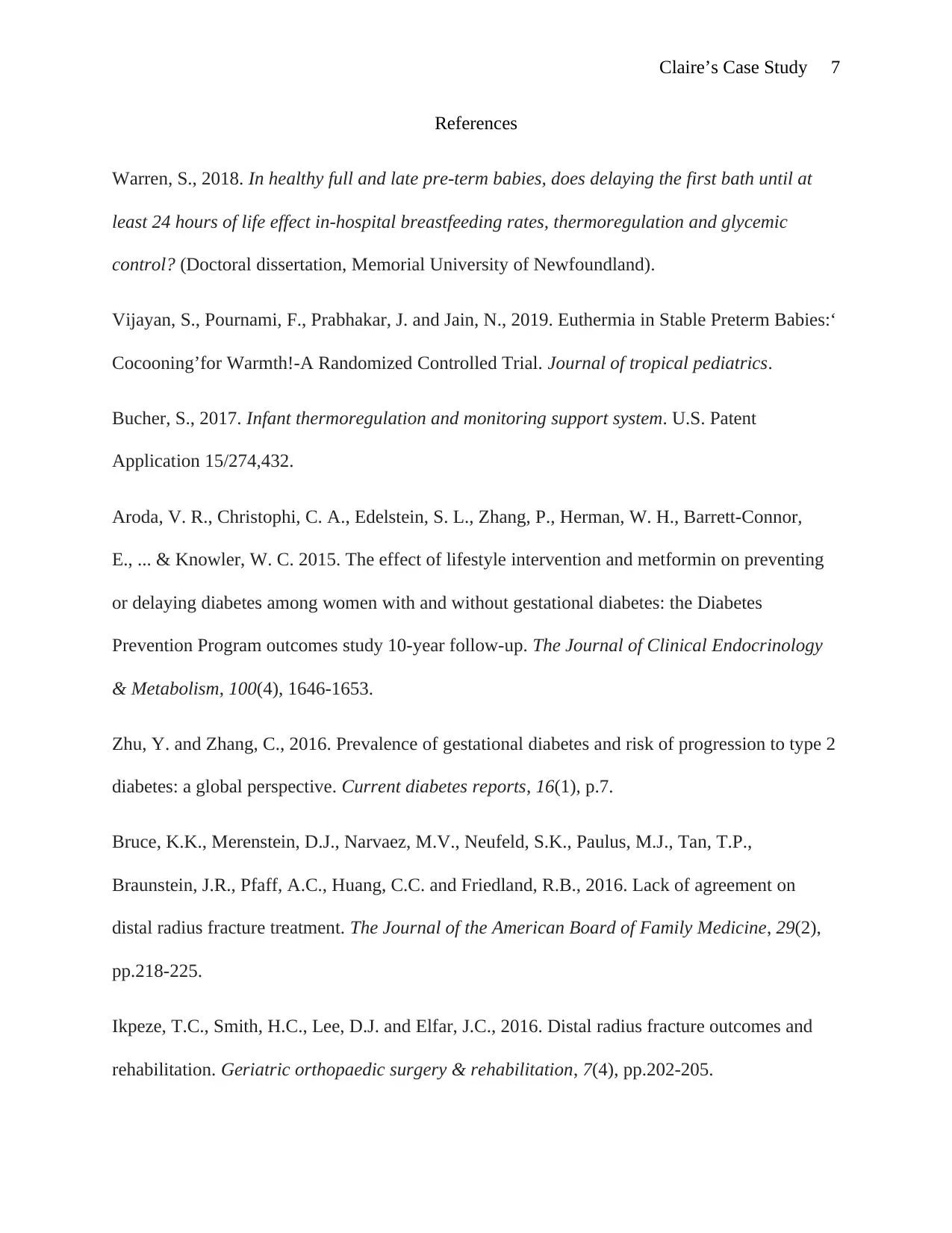
Claire’s Case Study 7
References
Warren, S., 2018. In healthy full and late pre-term babies, does delaying the first bath until at
least 24 hours of life effect in-hospital breastfeeding rates, thermoregulation and glycemic
control? (Doctoral dissertation, Memorial University of Newfoundland).
Vijayan, S., Pournami, F., Prabhakar, J. and Jain, N., 2019. Euthermia in Stable Preterm Babies:‘
Cocooning’for Warmth!-A Randomized Controlled Trial. Journal of tropical pediatrics.
Bucher, S., 2017. Infant thermoregulation and monitoring support system. U.S. Patent
Application 15/274,432.
Aroda, V. R., Christophi, C. A., Edelstein, S. L., Zhang, P., Herman, W. H., Barrett-Connor,
E., ... & Knowler, W. C. 2015. The effect of lifestyle intervention and metformin on preventing
or delaying diabetes among women with and without gestational diabetes: the Diabetes
Prevention Program outcomes study 10-year follow-up. The Journal of Clinical Endocrinology
& Metabolism, 100(4), 1646-1653.
Zhu, Y. and Zhang, C., 2016. Prevalence of gestational diabetes and risk of progression to type 2
diabetes: a global perspective. Current diabetes reports, 16(1), p.7.
Bruce, K.K., Merenstein, D.J., Narvaez, M.V., Neufeld, S.K., Paulus, M.J., Tan, T.P.,
Braunstein, J.R., Pfaff, A.C., Huang, C.C. and Friedland, R.B., 2016. Lack of agreement on
distal radius fracture treatment. The Journal of the American Board of Family Medicine, 29(2),
pp.218-225.
Ikpeze, T.C., Smith, H.C., Lee, D.J. and Elfar, J.C., 2016. Distal radius fracture outcomes and
rehabilitation. Geriatric orthopaedic surgery & rehabilitation, 7(4), pp.202-205.
References
Warren, S., 2018. In healthy full and late pre-term babies, does delaying the first bath until at
least 24 hours of life effect in-hospital breastfeeding rates, thermoregulation and glycemic
control? (Doctoral dissertation, Memorial University of Newfoundland).
Vijayan, S., Pournami, F., Prabhakar, J. and Jain, N., 2019. Euthermia in Stable Preterm Babies:‘
Cocooning’for Warmth!-A Randomized Controlled Trial. Journal of tropical pediatrics.
Bucher, S., 2017. Infant thermoregulation and monitoring support system. U.S. Patent
Application 15/274,432.
Aroda, V. R., Christophi, C. A., Edelstein, S. L., Zhang, P., Herman, W. H., Barrett-Connor,
E., ... & Knowler, W. C. 2015. The effect of lifestyle intervention and metformin on preventing
or delaying diabetes among women with and without gestational diabetes: the Diabetes
Prevention Program outcomes study 10-year follow-up. The Journal of Clinical Endocrinology
& Metabolism, 100(4), 1646-1653.
Zhu, Y. and Zhang, C., 2016. Prevalence of gestational diabetes and risk of progression to type 2
diabetes: a global perspective. Current diabetes reports, 16(1), p.7.
Bruce, K.K., Merenstein, D.J., Narvaez, M.V., Neufeld, S.K., Paulus, M.J., Tan, T.P.,
Braunstein, J.R., Pfaff, A.C., Huang, C.C. and Friedland, R.B., 2016. Lack of agreement on
distal radius fracture treatment. The Journal of the American Board of Family Medicine, 29(2),
pp.218-225.
Ikpeze, T.C., Smith, H.C., Lee, D.J. and Elfar, J.C., 2016. Distal radius fracture outcomes and
rehabilitation. Geriatric orthopaedic surgery & rehabilitation, 7(4), pp.202-205.
Paraphrase This Document
Need a fresh take? Get an instant paraphrase of this document with our AI Paraphraser

Claire’s Case Study 8
Boelig, R.C., Barton, S.J., Saccone, G., Kelly, A.J., Edwards, S.J. and Berghella, V., 2016.
Interventions for treating hyperemesis gravidarum. Cochrane Database of Systematic Reviews,
(5).
Boelig, R.C., Barton, S.J., Saccone, G., Kelly, A.J., Edwards, S.J. and Berghella, V., 2016.
Interventions for treating hyperemesis gravidarum. Cochrane Database of Systematic Reviews,
(5).
1 out of 8
Related Documents
Your All-in-One AI-Powered Toolkit for Academic Success.
+13062052269
info@desklib.com
Available 24*7 on WhatsApp / Email
![[object Object]](/_next/static/media/star-bottom.7253800d.svg)
Unlock your academic potential
Copyright © 2020–2025 A2Z Services. All Rights Reserved. Developed and managed by ZUCOL.



